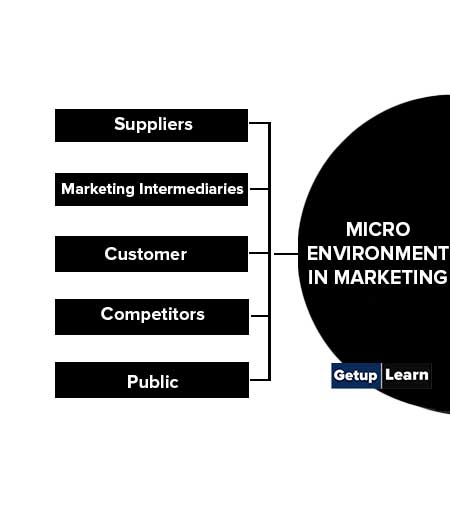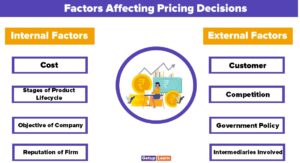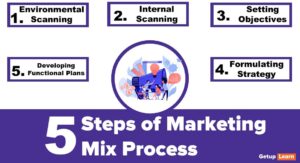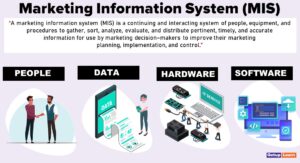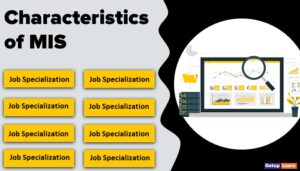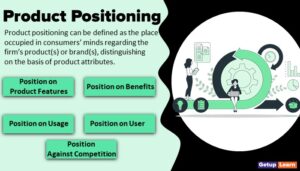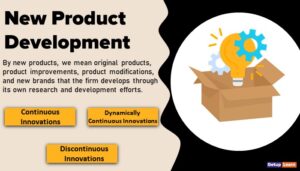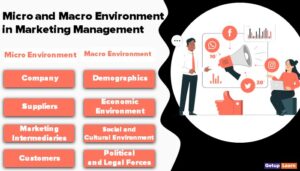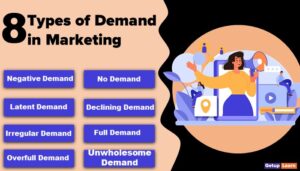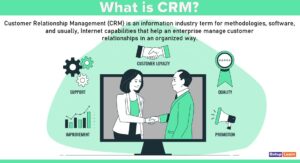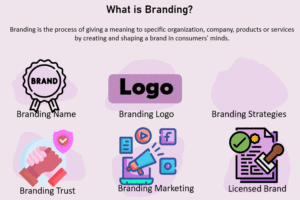Table of Contents
- 1 What is Marketing Mix?
- 2 Definition of Marketing Mix
- 3 4 Ps Marketing Mix
- 4 Also Read
- 5 Also Read
- 6 Also Read
- 7 Also Read
- 8 7 Ps Marketing Mix
- 9 4 Cs of Marketing Mix
- 10 Marketing Environment
-
11 FAQ Related to Marketing Mix
- 11.1 What is in a marketing mix?
- 11.2 What is the best definition of marketing mix?
- 11.3 What Are the 4 Ps of Marketing?
- 11.4 What is the 7 Ps Marketing Mix?
- 11.5 What are the 4 Cs of Marketing Mix?
- 11.6 What is meant by marketing environment?
- 11.7 What is macro environment in marketing mix?
- 11.8 What is the micro environment in marketing mix?
What is Marketing Mix?
A marketing Mix is a particular combination of the product, its price, the methods to promote it, and the ways to make the product available to the customer. Based upon its understanding of customers, a company develops its marketing mix of product, place, price, and promotion.
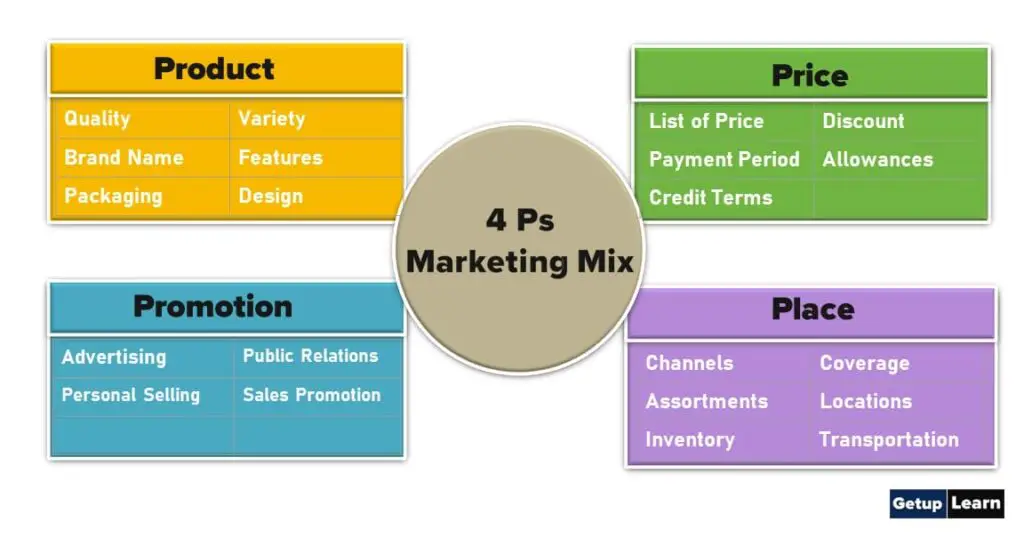
In other words, a Marketing Mix is a set of actions or tactics used by companies to promote and offer the actual product or services to potential customers. The marketing mix consists of four Ps i.e. Product, Price, Promotion, and Place.
The marketing mix elements are intricately and sensitively related to each other. The marketing mix is good or bad as a whole. All the elements have to reinforce each other to enhance the experience of the customer.
When a change is proposed to be made in one of the elements, it has to be checked if the changed element still fits with and reinforces other elements, or if it has started contradicting other elements, making the marketing mix less effective in serving customers.
Managers must manage the marketing mix in a way that indeed has the potential to address the customer needs better than the competition.
Definition of Marketing Mix
Following are the definitions of the marketing mix by the authors:
[su_quote cite=”Borden”]The marketing mix refers to the efforts, the combination, the design, and the integration of the elements of marketing into a program or mixes that, on the basis of an appraisal of the market forces, will best achieve an enterprise at a given time.[/su_quote]
[su_quote cite=”William J. Stanton”]The marketing mix is the term used to describe the combination of the four inputs which constitute the core of a company’s marketing system – the product, the price structure, the promotional activities, and the distribution system.[/su_quote]
[su_quote cite=”Philip Kotler”]Marketing Mix is the set of controllable variables that the firm can use to influence the buyer’s responsibility.[/su_quote]
4 Ps Marketing Mix
4 Ps Marketing Mix is assembled keeping in mind the needs of target customers, and it varies from one organization to another depending upon its available resources and marketing objectives.
Let’s briefly understand the 4 ps marketing mix:
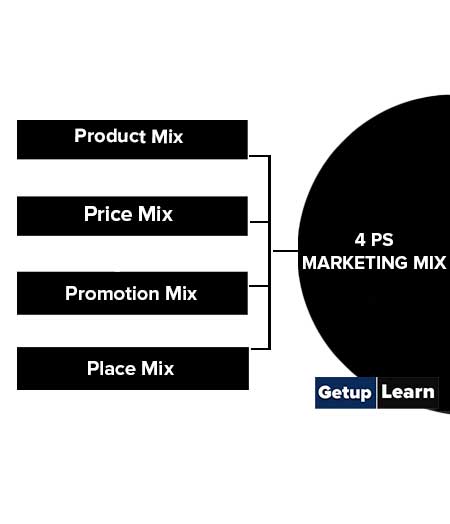
Product Mix
Product Mix: Product is the most important component of the marketing mix. Product means goods, materials, services, and even ideas. In marketing the word ‘product’ does not indicate only physical goods or materials.
It also indicates quality, price, brand, color, packaging, seller’s service, goodwill, reputation, guarantee, and warranty of goods with which the customers can get satisfaction. So, the product mix is an important component. it includes product planning, development, standardization, grading, branding, packaging, etc.
Price Mix
Price Mix: Price refers to the value that is put on a product. It depends on costs of production, segment targeted, the ability of the market to pay, supply-demand, and a host of other direct and indirect factors. There can be several types of pricing strategies, each tied in with an overall business plan. Pricing can also be used as a demarcation, to differentiate and enhance the image of a product.
Promotion Mix
Promotion Mix: Promotion refers to all the activities undertaken to make the product or service known to the user and trade. This can include advertising, word of mouth, press reports, incentives, commissions, and awards to the trade. It can also include consumer schemes, direct marketing, contests, and prizes.
Place Mix
Place Mix: Place refers to the point of sale. In every industry, catching the eye of the consumer and making it easy for her to buy it is the main aim of a good distribution or ‘place’ strategy. Retailers pay a premium for the right location. In fact, the mantra of a successful retail business is ‘location, location, location.
7 Ps Marketing Mix
Marketing mix refers to the primary elements that must be attended to in order to properly market a product or service. A marketing mix is the combination of seven elements: Product, Place, Price, Promotion, People, Physical Evidence, and Process. They are called the 7 Ps of the marketing mix:
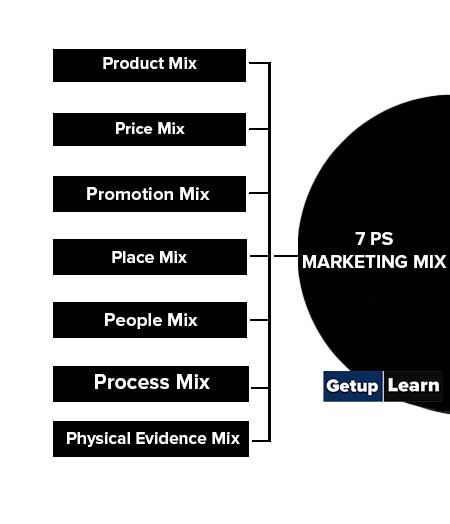
Product Mix
Before making a product the company should focus on what customers want and need and then accordingly they should develop a product to meet the need of the potential customers. Let‘s consider, that the competitor‘s products offer the same benefits, same quality, and same price.
In such a scenario you should differentiate your product with the following:
- Design
- Technology
- Usefulness
- Convenience
- Quality
- Packaging
- Accessories
- Warranty
Price Mix
A product is only worth it if a customer is prepared to pay for it. Therefore, the companies focus on various pricing strategies while pricing their products:
-
Premium Pricing: This strategy involves using high pricing where there is a uniqueness about the product or service. This approach is used where a substantial competitive advantage exists. Such high prices are charged for luxuries such as Cruises, Luxury Hotel rooms, and Designer products.
-
Penetration Pricing: It is the strategy of entering the market with a low initial price to capture a greater market share.
-
Price Skimming: The practice of price skimming‘ involves charging a relatively high price for a short time when a new, innovative, or much-improved product is launched into a market. The prices are set high in order to attract the least price-sensitive customers to generate high profits.
- Competitive Pricing: If your product is sold at the lowest price among all your competitors, you are practicing competitive pricing. Sometimes, competitive pricing is essential. For instance, when the products are basically the same, this strategy will usually succeed.
Promotion Mix
This is the way in which you communicate to your potential customers about your product. It includes the various ways of communicating to the customers what the company has to offer. It is about communicating the features/ benefits of using a particular product or service.
-
Advertisement: It takes many forms like TV, radio, internet, newspapers, yellow pages, Leaflets, Posters, etc.
-
Sales Promotion: Buy One Get One Free. Others include couponing, money-off promotions, free accessories (such as free blades with a new razor), introductory offers (such as buying digital TV and getting free installation), and so on.
- Personal Selling: It is an effective way to manage personal customer relationships. The salesperson acts on behalf of the organization.
Place Mix
Place refers to the place where the customers can buy the product and how the product reaches out to that place. This is done through different channels like:
- Retails
- Wholesale
- Internet
- Mail Orders
- Direct Sales
People Mix
An essential ingredient to any service provision is the use of appropriate staff and people. Recruiting the right staff and training them appropriately in the delivery of their service is essential if the organization wants to obtain a form of competitive advantage.
Staff should have the appropriate interpersonal skills, attitude, and service knowledge to provide the service that consumers are paying for.
Process Mix
Process refers to the methods and processes of providing service which help the customers get what they want. Always keep customers informed. This can be done at the store or through faxes and emails.
Physical Evidence Mix
This is particularly important in services marketing as it is the only physical item that a customer will see and so it must reflect the image that the service is trying to project. It includes some of the following:
- Internet/web pages.
- Brochures.
- Furnishings.
- Signage (such as those on aircraft and vehicles).
- Uniforms.
- Business cards.
- The building itself (such as prestigious offices or scenic headquarters).
Example: If you walk into a restaurant your expectations are of a clean, friendly, hygienic environment that will want you to visit again.
4 Cs of Marketing Mix
In 1993, Robert F. Lauterborn proposed a 4 cs of marketing which is a more consumer-oriented version of the 4 ps that attempts to better fit the movement from mass marketing to niche marketing.
Following are the 4 cs of marketing mix that are explained below:
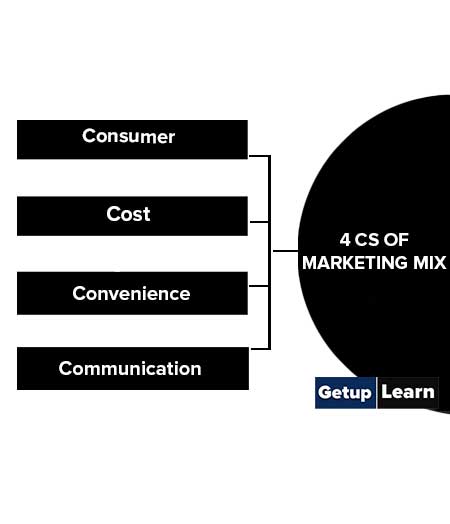
Consumer
The product part of the 4 Ps model is replaced by “Consumer”, shifting the focus to satisfying the consumer needs. By defining offerings as individual capabilities that are combined and focused on a specific industry, the result is a custom solution rather than the pigeon-holing of a customer into a product.
Cost
Price is replaced by “Cost”, reflecting the total cost of ownership. Many factors affect Cost, including but not limited to the customer’s cost to change or implement the new product or service and the customer’s cost for not selecting a competitor’s products or services.
Convenience
The place is replaced by “convenience”. With the rise of the internet and hybrid models of purchasing, Place is becoming less relevant. Convenience takes into account the ease of buying the product, finding the product, finding information about the product, and several other factors.
Communication
Promotion is replaced by “Communication”, which represents a broader focus. Communication can include advertising, public relations, personal selling, viral advertising, and any form of communication between the organization and the consumer.
Marketing Environment
The concept of marketing is broad and cannot be practiced in isolation. Marketing activities are influenced by a number of factors. These factors directly or indirectly affect the company. The marketing environment is the factor that surrounds a company or firm to influence its activities.
According to Kotler, the marketing environment refers to the external factor and forces that affect the company’s ability to develop and maintain a successful relationship with target customers.
The marketing environment consists of both internal and external forces. Internal forces are inherent to the firm and can be controlled by the management, whereas external abilities of the industry as a whole rather than individual players. The types of marketing environment:
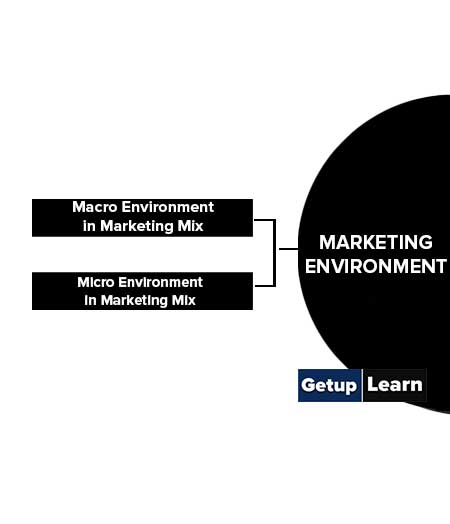
Macro Environment in Marketing Mix
These are the factors that lie external to the companies. The macro-environment doesn’t have a direct effect on a firm’s internal operation, however, they have an indirect effect on the long-run operation of the business.
Macro environmental factors are dynamic and keep on changing over time. Demographics, legal, political, social-cultural, technological, economic, and natural forces are included in macro-environmental factors. Firms, therefore, need to adapt to these changing forces to win over competitors.
Ex: Notable change in technology in the industry may not immediately hamper the firm’s ability to trade, but once the new technology is made known to the customers, they don’t seek to purchase the old ones.
Following is the macro environment in marketing mix:
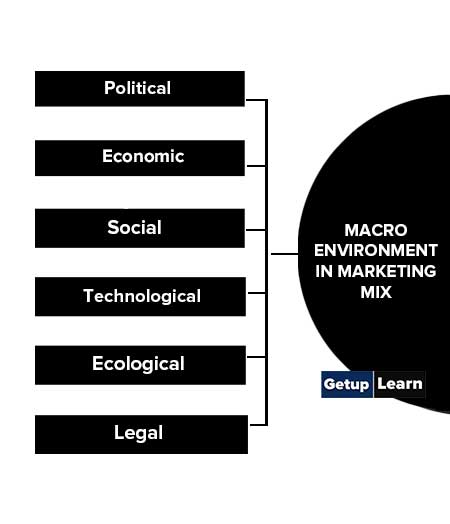
Political
The political environment includes taxation policy, government stability, and foreign trade regulations.
Economic
The economic environment includes interest rates, inflation, business cycles, unemployment, disposable, income, energy, availability, and cost.
Social
The social/cultural environment includes population demographics, social mobility, income distribution, lifestyle changes, attitudes to work and leisure, levels of education, and consumerism.
Technological
Technological is influenced by government spending on research, new discoveries, and development, government and industry focus on technological effort, speed of technological transfer, and rates of obsolescence.
Ecological
It considers the ways in which the organization can produce its goods or services with minimum environmental damage.
Legal
Legal covers areas such as taxation, employment, law, monopoly, legislation, and environmental protection laws.
Micro Environment in Marketing Mix
There are three external micro environment forces that are more directly related to the form and are more controllable than the large micro environmental forces.
Following are the three micro environment in marketing mix:
Suppliers
For any organization, suppliers have a vital role in the entire marketing process. The role of a supplier has an indirect impact on the firm’s marketing effort. However, they play an essential role because of the following:
- The supply dimension is fulfilled by the suppliers, they strive to maintain equilibrium between the demand and the supply position, to reduce the supply gap in the market.
- Supply determines the strength and quality of final goods produced by the producer.
- Supplies are flexible enough to cope with the dynamic requirement of the organizational production process.
Marketing Intermediaries
The intermediaries are the organizations that help in the flow of goods or services between marketers and the markets by being willing and able to assist the company in implementing their plans for market-related activities like advertising, sales promotion, physical distribution, and maintaining the images of the company by stocking, storing and selling the merchandise and associated service effect.
Customer
Customers are the focal points of any business. They are the individuals who purchase the firm’s product. The firm’s customers are end-users and tend to influence the demand and profit of the organization. A firm should implement a proper attraction and retention policy for the customer for the overall development of the firm.
Competitors
Competitors are those who sell goods and services of a similar description, in the same market. Apart from competition on the basis of price factors, product differentiation is also a powerful tool for the creation of healthy competition. It becomes very necessary to identify and monitor the competitor’s moves to neutralize the competition effect.
Public
The public is the people who stay in a particular locality or society. More precisely it can be defined as ‘any group that has an actual or potential interest in or impact on a company to achieve its objective.
It is the study of the firm to satisfy the needs and wants of the people of the society, for the survival of the business in the long run. Public relations therefore should be maintained, to create goodwill for the company’s brand for future survival.
What is in a marketing mix?
The marketing mix refers to the set of actions, or tactics, that a company uses to promote its brand or product in the market. The 4Ps make up a typical marketing mix – Price, Product, Promotion and Place. McCarthy classified these tools into four broad groups that he called the four P’s of marketing: Product, Price, Place and Promotion.
What is the best definition of marketing mix?
The marketing mix refers to the efforts, the combination, the design, and the integration of the elements of marketing into a program or mixes that, on the basis of an appraisal of the market forces, will best achieve an enterprise at a given time. By Borden
What Are the 4 Ps of Marketing?
These are the 4 ps of marketing:
1. Product Mix
2. Price Mix
3. Promotion Mix
4. Place Mix.
What is the 7 Ps Marketing Mix?
These are the 7 ps marketing mix given below:
1. Product Mix
2. Price Mix
3. Promotion Mix
4. Place Mix
5. People Mix
6. Process Mix
7. Physical Evidence Mix.
What are the 4 Cs of Marketing Mix?
What is meant by marketing environment?
The marketing environment consists of both internal and external forces. Internal forces are inherent to the firm and can be controlled by the management, whereas external abilities of the industry as a whole rather than individual players.
What is macro environment in marketing mix?
Following are the macro environment in marketing mix:
1. Political
2. Economic
3. Social
4. Technological
5. Ecological
6. Legal.
What is the micro environment in marketing mix?
Micro environment in marketing mix is given below:
1. Suppliers
2. Marketing Intermediaries
3. Customer
4. Competitors
5. Public.

